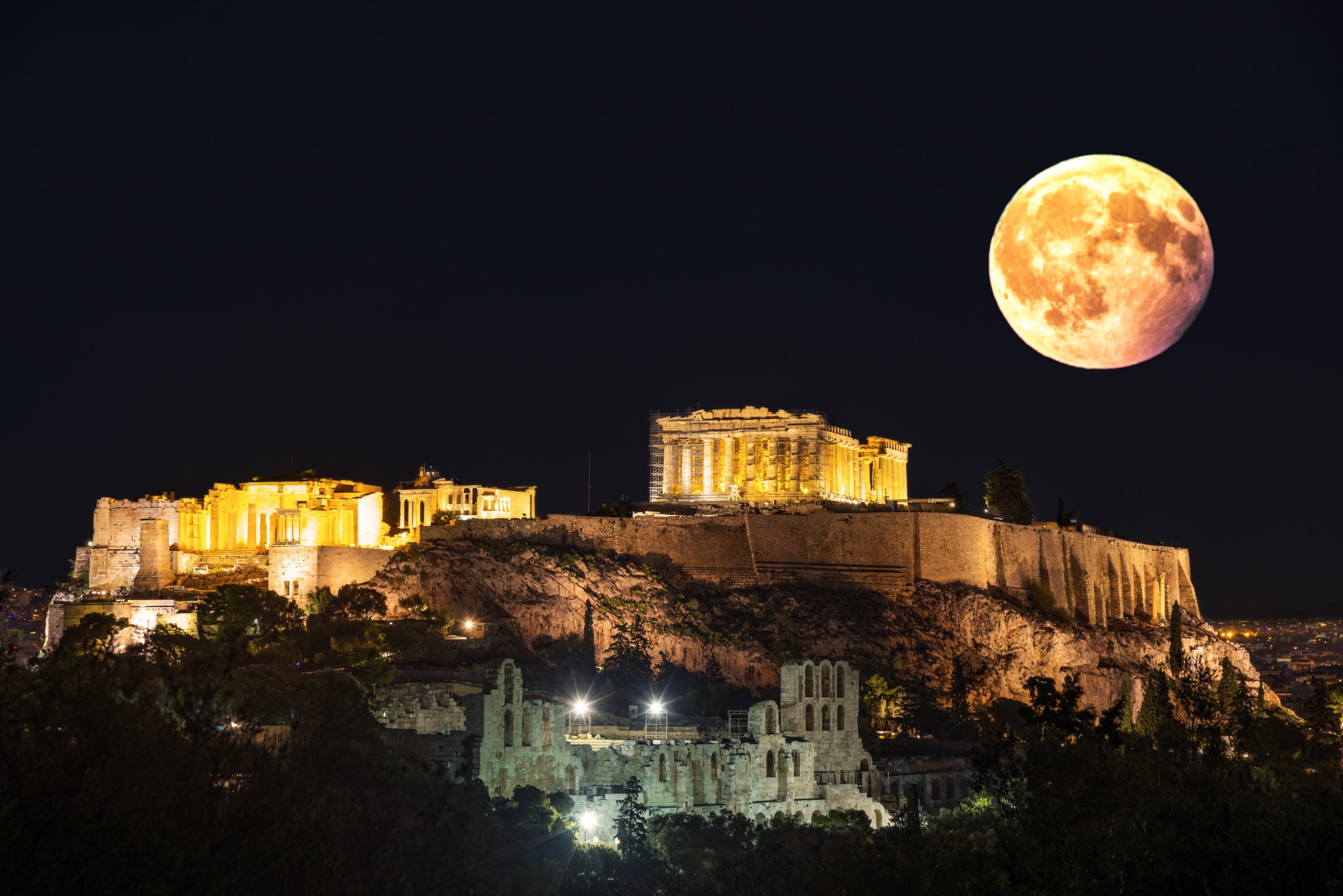
The man who captained the first mission to orbit the moon was not, truth be told, terribly impressed by what he experienced. Frank Borman, the commander of Apollo 8, which circled the moon 10 times on Christmas Eve and Christmas Day 1968, was candid when we chatted one day back in 2015. We met in his private airplane hangar in Billings, Montana, and I asked Borman, now 94, if, living out in big sky country, he doesn’t sometimes gaze up at the full moon at night and think, “I was there. I called that home.”
“Nah,” Borman responded with a wave. “I’ve tried that once or twice because people always tell me I should feel like that, but it just doesn’t work.”
This week, Borman might regard the moon with the same nonchalance, but the rest of us will be seeing it with different, more enchanted eyes—at least from moonrise today until moonset tomorrow. That’s when the sky will be decorated by the much-anticipated Strawberry Supermoon.
The moon was born in violence 4.5 billion years ago, when a planetesimal the size of Mars collided with Earth, sending a vast belt of debris into space. The belt coalesced into a cloud, and the cloud into a moon, which drifted back to a stable orbit averaging 382,000 km (roughly 238,000 mi.) from Earth. From there, the now peaceable moon helps stabilize our seasons and regulates our tides, circling the planet once every 27 days, 7 hours, and 43 minutes.
But the moon’s orbit isn’t perfect. Irregular and egg-shaped, it can be as far as 406,000 km (252,000 mi) from Earth and as close as 357,000 km (222,000 mi). At its closest approach, or perigee, the moon appears 30% larger and 17% brighter than it usually does. And when that perigee happens to coincide with a full moon, as it does today, that’s when you get the dazzling phenomenon known as a supermoon.
There is a full moon every month, of course, but supermoons are rarer, happening three to four times a year, from May to August. The new Strawberry Moon does not get its name from the color the moon will appear to be. The popular Blood Moons happen during a lunar eclipse—when the Earth moves between the moon and the sun—and the moon does appear reddish. This occurs because the Earth’s atmosphere scatters blue wavelengths of sunlight streaming through it, allowing only red to pass through, which turns the moon a faint scarlet. A Strawberry Moon, meanwhile, will be the same color as the moon ordinarily appears; only its size and luminosity will change.
The moniker “Strawberry Moon” is instead a linguistic gift from the Algonquin Native American tribe, who named the supermoon that occurs in June after the brief strawberry harvesting season that happens at the same time of year. Whatever it’s called, the latest supermoon will be at its closest, fullest, and brightest at 7:24 PM ET tonight. Given the season and the tilt of the Earth, the Strawberry Moon will never climb terribly high in the sky, rising a maximum of 23 degrees above the horizon on Wednesday morning—or about a quarter of the way above ground level. The best viewing then, is away from tall buildings or stands of trees, in open country or on relatively clear land.
There’s no telling if Borman will be watching tonight or tomorrow, but not every astronaut who orbited or touched the moon returned to Earth as unmoved as he did. Dave Scott, the commander of Apollo 15, once told me of the welcome-home barbecue his neighborhood threw him when he returned from the moon in 1971. He recalls standing in his backyard with a beer, gazing up at the moon and thinking how surreal it seemed that just a week earlier he had been there. His Houston lawn was beneath his feet now, but seven days earlier it had been the soil of the moon under his boots, dirtying his uniform, and in the very air he breathed when he climbed back inside his spacecraft and shucked the bulky, dusty pressure suit.
Scott got to cross that quarter million mile distance between here and there. The rest of us never will—but as a species we long to do so. That’s why the little shard of moon on display in the National Air and Space Museum in Washington, D.C., that people are permitted to touch, has been rubbed smooth in the decades it’s been in place. That’s why we gaze up at a full moon with such fascination—so close to us on a cosmic scale but so far away in all other respects. And that’s why we’ll be enchanted all the more when the moon nudges a tantalizing bit closer, hovering in the sky just 357,657 km (222,238 mi) away. It’s a huge distance to travel, but to us, however briefly, it will seem like an arm’s reach.
More Must-Reads from TIME
- Breaking Down the 2024 Election Calendar
- How Nayib Bukele’s ‘Iron Fist’ Has Transformed El Salvador
- What if Ultra-Processed Foods Aren’t as Bad as You Think?
- How Ukraine Beat Russia in the Battle of the Black Sea
- Long COVID Looks Different in Kids
- How Project 2025 Would Jeopardize Americans’ Health
- What a $129 Frying Pan Says About America’s Eating Habits
- The 32 Most Anticipated Books of Fall 2024
Write to Jeffrey Kluger at jeffrey.kluger@time.com